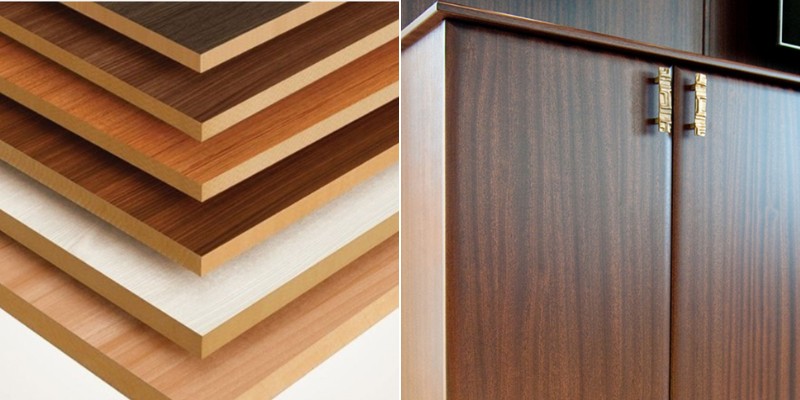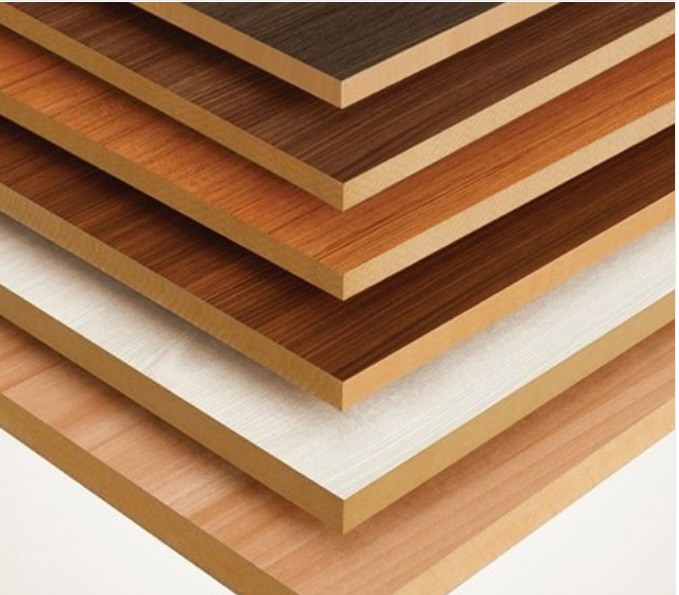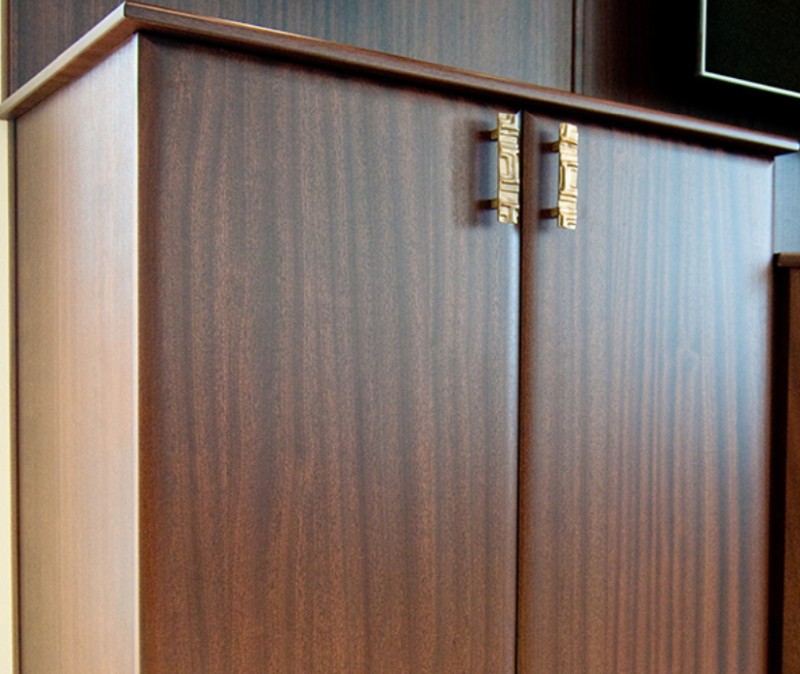Cabinetry has come a long way in the last two decades. It used to be that you either went high-end with solid wood bases and doors or you could opt for plywood or particle board with a laminate finish.

One of the newest players in the cabinet market that is gaining momentum is MDF or Medium Density Fiberboard.
When it comes to cabinet doors, whether new or for a kitchen or bathroom remodel, solid wood and MDF doors are the clear choices these days.
So, what’s the difference, and is one better than the other? Let’s compare MDF vs Solid Wood cabinets in a little more detail so you can make an informed decision.
What are MDF Cabinet Doors?
Medium Density Fiberboard (MDF) is a type of engineered lumber that is made up of wood by-products that are basically the waste materials of milled lumber.

These materials include sawdust and wood shavings that are sourced from sawmills. They are ground into a powder, dried, and then combined with resins and wax to stabilize the material.
Using high pressure, this is pressed into board and panel sections for use primarily in cabinetry and for trim.
MDF is commonly used as a material for cabinet doors and drawer fronts for both new installations and for the replacement of cabinet fronts.
It isn’t used as much for cabinet base boxes. MDF doors generally receive a durable painted finish.
What are Solid Wood Cabinet Doors?
Solid wood cabinet doors are milled from natural woods, such as oak, maple, walnut, and cherry.

There isn’t any resin, wax, or adhesive added to the wood. Natural wood is cut from felled and dried logs.
The bark is removed and the surfaces are planed and sanded to a smooth finish.
Solid wood doors can be a single flat panel or a 5-piece system with a center panel that is trimmed with interlocking stiles and rails at the sides, top, and bottom. Solid wood doors can also be carved and shaped to create unique details.
Solid wood is one of the most popular materials for cabinet doors due to its versatility in terms of finishes.
They can be stained to accentuate the natural grain or painted. Solid wood is best suited for cabinet doors that are applied to solid wood or plywood cabinet bases.
Pros and Cons of MDF Cabinet Doors
There are definitely some advantages to using MDF for cabinet doors such as:
Advantages of MDF Cabinet Doors
Sustainability: One of the most popular reasons for using MDF in our current “green” environment is that it is made from the waste products of the milling process of wood, notably sawdust and wood shavings. Basically, it is considered a recycled material.
Stability: MDF is extremely stable due to the manufacturing process and the additives. The material isn’t prone to cracking or warping when exposed to humidity differentials and temperature fluctuations in most indoor environments.
Smooth Finish: The beauty of MDF is in how it receives paint, especially when factory-finished. There isn’t any grain or imperfections, so the surface is pristine and smooth.
Value: One of the most attractive features of MDF is the cost. Compared to solid wood and plywood, MDF is a better value, especially when you consider how durable it is. It will last a long time, giving it a great return on investment.
Disadvantages of MDF Cabinet Doors
There are a few cons associated with MDF cabinet doors:
Strength: While MDF is a strong material, it is not as strong as plywood and certain hardwood species that are considered to be of structural quality.
Surface Damage: Similar to solid wood, MDF is not immune to dings, dents, and scratches. As well, it is not easily repairable. MDF can’t be sanded to remove imperfections.
Emissions: MDF has certain additives that may contain urea-formaldehyde and similar volatile organic compounds (VOCs) that can present as a health risk if emitted. It is worth noting that well-sealed (painted) MDF doors are less likely to emit VOCs. Also, studies showed that VOC emissions from MDF are usually low.
Pros and Cons of Solid Wood Cabinet Doors
There are many reasons why lots of people choose solid wood doors:
Advantages of Solid Wood Cabinet Doors
Attractive: One of the most appealing things about solid wood cabinet doors is their appearance. While solid wood can be painted, many people love the richness of a stained and sealed wood door with the grain of the wood being allowed to show through. There is something warming about the natural grain and the color of solid wood.
Durability: Solid wood has a reputation for being strong and durable. Wood cabinet doors will last for several decades if cared for properly. The strength of wood doors varies by species. For instance, pine is softer than oak.
Variety: There are so many different types of wood to choose from, each with its own grain and color characteristics. Solid wood cabinet doors are more customizable than other materials, offering a variety of styles and unique details.
Disadvantages of Solid Wood Cabinet Doors
There are some disadvantages associated with solid wood for cabinet doors:
Expansion and Contraction: Solid wood is a porous material and is susceptible to fluctuations in temperature and humidity levels. In very dry, warm environments, solid wood can shrink and crack. In moist conditions, wood will expand and swell. This can cause doors to warp and not close properly.
Water Damage: In the unfortunate event that your space experiences exposure to water from a flood or leaks, the water will damage the wood and could encourage mold growth. Well-sealed solid wood doors are less susceptible to moisture damage.
Cost: If you are on a tight budget, solid wood might not be an option. It is definitely one of the more expensive materials for cabinet doors. They take a bit longer to fabricate and do need to be maintained once installed.
Best Use for MDF Cabinet Doors
MDF doors are ideal for areas of higher humidity. They are perfect for bathroom vanities and finished basements.
You might also consider them for storage cabinets in an attached garage. Of course, they can be used in kitchens if you are looking to stay within a specified budget. MDF is sleek and clean, making it a good choice for contemporary interiors.
Best Use for Solid Wood Cabinet Doors
There is no denying that solid wood doors are good-looking and often the desired choice for kitchen and bar cabinets.
In addition to the finish options, solid wood doors are highly customizable. If you are going for a high-end appearance, solid wood cabinet doors are an excellent return on investment for highly visible locations.
Solid wood would not be appropriate for use in unconditioned areas or outdoors. Solid wood is appropriate for more traditional and classic interior spaces.
Bottom Line
Both MDF and solid wood cabinet doors are excellent choices, each offering its own advantages.
MDF is a somewhat sustainable product that offers stability and longevity at an attractive price point. Solid wood is versatile, good-looking, and extremely durable.
There are a few cons to consider with both products. MDF is less strong than solid wood, can show imperfections from damage, and does not withstand heat very well.
Solid wood expands and contracts when exposed to very dry or very humid conditions. It does require periodic maintenance and costs more than MDF.
In the end, both MDF and solid wood are good choices for cabinet doors and drawer fronts.
If you are trying to stay within a budget and going for a more contemporary look, MDF might be the better choice.
If you want a more classic look and feel to your space, and money is of no object, I would encourage you to choose solid wood doors.
Related Posts
- 11 Ways to Get Rid of Cooking Smells in a Small Apartment or House
- Comparison of Corian Countertops vs Laminate for Kitchens
- All About Fragranite Kitchen Sinks With Pros & Cons
- Comparison of Granite Composite Sink vs Stainless Steel
- How Much Does it Cost to Paint Kitchen Cabinets?
- What Color Granite Goes With Maple Wood Kitchen Cabinets?
Leave a Reply